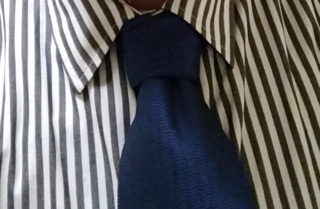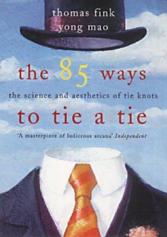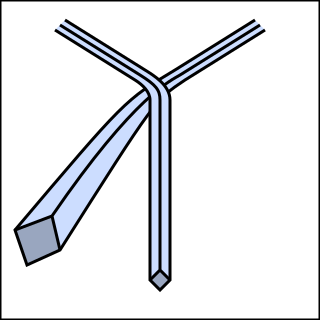
The overhand knot is one of the most fundamental knots, and it forms the basis of many others, including the simple noose, overhand loop, angler's loop, reef knot, fisherman's knot, half hitch, and water knot. The overhand knot is a stopper, especially when used alone, and hence it is very secure, to the point of jamming badly. It should be used if the knot is intended to be permanent. It is often used to prevent the end of a rope from unraveling. An overhand knot becomes a trefoil knot, a true knot in the mathematical sense, by joining the ends. It can also be adjusted, faired, or mis-tied as a half hitch.

The clove hitch is an ancient type of knot, made of two successive single hitches tied around an object. It is most effectively used to secure a middle section of rope to an object it crosses over, such as a line on a fencepost. It can also be used as an ordinary hitch, or as a binding knot, but it is not particularly secure in either application. It is considered one of the most important knots, alongside the bowline and the sheet bend.
Although the name clove hitch is given by Falconer in his Dictionary of 1769, the knot is much older, having been tied in ratlines at least as early as the first quarter of the sixteenth century. This is shown in early sculpture and paintings. A round turn is taken with the ratline and then a hitch is added below. The forward end is always the first to be made fast.

The packer's knot is a binding knot which is easily pulled taut and quickly locked in position. It is most often made in small line or string, such as that used for hand baling, parcel tying, and binding roasts. This latter use, and its general form, make it a member of a class of similar knots known as butcher's knots.

A neckerchief, sometimes called a necker, kerchief or scarf, is a type of neckwear associated with those working or living outdoors, including farm labourers, cowboys and sailors. It is most commonly still seen today in the Scouts, Girl Guides and other similar youth movements. A neckerchief consists of a triangular piece of cloth or a rectangular piece folded into a triangle. The long edge is rolled towards the point, leaving a portion unrolled. The neckerchief is then fastened around the neck with the ends either tied or clasped with a slide or woggle.

A shirt is a cloth garment for the upper body.

A necktie, or simply a tie, is a piece of cloth worn for decorative purposes around the neck, resting under the shirt collar and knotted at the throat, and often draped down the chest.

The bow tie or dicky bow is a type of necktie. A modern bow tie is tied using a common shoelace knot, which is also called the bow knot for that reason. It consists of a ribbon of fabric tied around the collar of a shirt in a symmetrical manner so that the two opposite ends form loops.

The Windsor knot, sometimes referred to as a full Windsor to distinguish it from the half-Windsor, is a knot used to tie a necktie. As with other common necktie knots, the Windsor knot is triangular, and the wide end of the tie drapes in front of the narrow end. The Windsor is a wider knot than most common knots, and while not truly symmetric is more balanced than the common four-in-hand knot. The Windsor's width makes it especially suited to be used with a spread or cutaway collar.

The sheet bend is a bend knot. It is practical for joining lines of different diameter or rigidity.

The buntline hitch is a knot used for attaching a rope to an object. It is formed by passing the working end around an object, then making a clove hitch around the rope's standing part and taking care that the turns of the clove hitch progress towards the object rather than away from it. Secure and easily tied, the buntline hitch will jam when subjected to extreme loads. Given the knot's propensity to jam, it is often made in slipped form.
The buntline hitch, when bent to a yard, makes a more secure knot than two half hitches, but is more liable to jam. It differs from two half hitches in that the second half hitch is inside instead of outside the first one.

The four-in-hand knot is a method of tying a necktie. It is also known as a simple knot or schoolboy knot, due to its simplicity and style. Some reports state that carriage drivers tied their reins with a four-in-hand knot, while others claim that the carriage drivers wore their scarves in the manner of a four-in-hand, but the most likely etymology is that members of the Four-in-Hand Club in London began to wear the neckwear, making it fashionable. The knot produced by this method is on the narrow side, notably asymmetric. For United States Army uniforms, and United States Navy uniforms that include a necktie, the four-in-hand knot is one of three prescribed options for tying the necktie, the other two being the half-Windsor and Windsor.

The Pratt knot is a method of tying a necktie. It is also known as the Shelby knot and the Pratt-Shelby. The knot was created by Jerry Pratt, an employee of the US Chamber of Commerce in the late 1950s. It was popularized as the Shelby knot after then 92-year-old Pratt taught it in 1986 to television reporter Don Shelby who he felt had been tying his tie poorly on the air. Shelby then refined the Pratt knot with local clothier Kingford Bavender and wore it on the air with a spread collar where it stood out and attracted attention for its symmetry and trim precision.
A tie press is a device, based solely on pressure, to flatten neckties. Its use is necessitated by ties usually being of silk or some other textile ill-suited to the heat of ironing.

The small knot, also known as oriental knot, Kent knot or simple knot, is the simplest method of tying a necktie, though some claim the simple knot is an alternative name for the four-in-hand knot. The small knot is not very well known despite its simplicity. One of the reasons may be that the small knot is not self-releasing, and may annoy people accustomed to four-in-hand and Windsor knots who pull at the tie to untangle the knot. Additionally, it is a common opinion that, should the thin end of the tie become visible, it not be "inside out"; the small knot is one of several that violate this preference, though this can be remedied by giving the entire tie a half-twist during the tying process.

The 85 Ways to Tie a Tie is a book by Thomas Fink and Yong Mao about the history of the knotted neckcloth, the modern necktie, and how to tie each. It is based on two mathematics papers published by the authors in Nature and Physica A while they were research fellows at Cambridge University’s Cavendish Laboratory. The authors prove that, assuming both the tie and the wearer to be of typical size, there are exactly 85 ways of tying a necktie using the conventional method of wrapping the wide end of the tie around the narrow end. They describe each and highlight those that they determine to be historically notable or aesthetically pleasing.

A decorative or ornamental knot is an often complex knot exhibiting repeating patterns. A decorative knot is generally a knot that not only has practical use but is also known for its aesthetic or ornamental qualities. Often originating from maritime use, "decorative knots are not only serviceable and functional but also enhance the ship-shape appearance of any vessel." Decorative knots may be used alone or in combination, and may consist of single or multiple strands.
Though the word decorative sometimes implies that little or no function is served, the craft of decorative knot tying generally combines both form and function.

The Grantchester knot is a self-releasing, asymmetric way of tying a necktie. Using the notation presented in The 85 Ways to Tie a Tie, it is a Lo Ri Lo Ri Co Li, finishing with Ro Li Co T.

The reef knot, or square knot, is an ancient and simple binding knot used to secure a rope or line around an object. It is sometimes also referred to as a Hercules knot. The knot is formed by tying a left-handed overhand knot between two ends, instead of around one end, and then a right-handed overhand knot via the same procedure, or vice versa. A common mnemonic for this procedure is "right over left; left over right", which is often appended with the rhyming suffix "... makes a knot both tidy and tight". Two consecutive overhands tied as described above of the same handedness will make a granny knot. The working ends of the reef knot must emerge both at the top or both at the bottom, otherwise a thief knot results.
The reef knot or square knot consists of two half knots, one left and one right, one being tied on top of the other, and either being tied first...The reef knot is unique in that it may be tied and tightened with both ends. It is universally used for parcels, rolls and bundles. At sea it is always employed in reefing and furling sails and stopping clothes for drying. But under no circumstances should it ever be tied as a bend, for if tied with two ends of unequal size, or if one end is stiffer or smoother than the other, the knot is almost bound to spill. Except for its true purpose of binding it is a knot to be shunned.


















